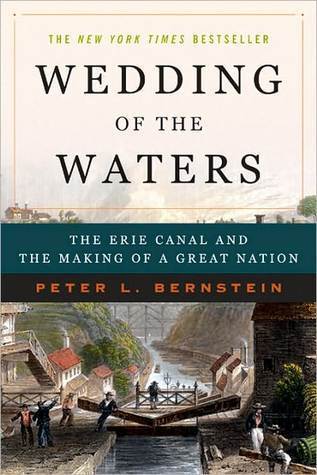Wedding of the Waters
 For a long time, waterways were the only meaningful passages from one place to another. Roads might do in a pinch, but water was much faster and easier. Canals have been used throughout history to get this fact to work for you when nature had been ungenerous. The Erie Canal is one of the more spectacular successes of these projects, and important in the early history of the United States. Bernstein’s Wedding of the Waters is a good popular history of the creation of a 363-mile long canal through upstate New York.
For a long time, waterways were the only meaningful passages from one place to another. Roads might do in a pinch, but water was much faster and easier. Canals have been used throughout history to get this fact to work for you when nature had been ungenerous. The Erie Canal is one of the more spectacular successes of these projects, and important in the early history of the United States. Bernstein’s Wedding of the Waters is a good popular history of the creation of a 363-mile long canal through upstate New York.
He starts out with lots of background, including the general mechanics of canals, how and why locks work, and various high points in the development of canals, including the Manchester Canal in England, which inspired a lot of further canal building at the time. This section is definitely appreciated, but I wished for more. There’s a good map of the canal, and a side elevation of the canal showing how it goes up and down, and where the locks are, but that is it. No general diagrams of a section, or the locks, or illustrations/photographs of some of the more impressive features. And some of it is really hard to picture on your own.
After the introductory parts, Bernstein starts talking about the idea of a canal linking the East Coast with the interior, namely the area across the Alleghenies. The Founding Fathers, and Washington in particular were aware of a need to tie the economy of the area to the east so that there would not be a drift toward independence, or dependence on whoever held the Mississippi. Washington tried a scheme to clear the Potomac towards such a goal, but did not get far. Meanwhile, the fact that there was a practical route across New York to the Great Lakes was becoming more obvious. An initial attempt was to clear the path of the Mohawk River westwards, but the Western Inland Lock Navigation Company soon found it was spending all the money it could raise on trying to keep a relatively short section of riverbed clear. (There was also a Northern Inland Lock Navigation Company to improve conditions between Albany and Lake Champlain, but I can’t find any mention of its fate.)
These false starts, thanks to a number of influential people, fail to stop all support for such schemes, but instead focus support on the most ambitious option of all: Building a brand new waterway the entire length of modern New York state. One of the nice parts of the book is the earlier sections talk about the evolution of these ideas through colonial times as well as post-Revolution. Bernstein even talks about the initial exploration of the Hudson (which was part of looking for the fabled Northwest Passage). But of course the later parts get more detail and attention, as they focus on the actual subject of the book.
Bernstein also points out that there was no one in America at the time who could be termed a Civil Engineer, even by the standards of the day. Other than the politicians working for budget appropriations, everyone involved in the project is an amateur. A number of different technical problems are discussed, and some of them were solved by workers on site, and we’ll never know who came up with the idea.
There is, of course, a lot of discussion of the politics involved. New York had the most developed political scene of the era in the US, so the infighting was also more developed. First, fighting over the proposal, and if it should be funded, then when things went well, fighting over the credit, and who is in charge. As I have been reading a few other books on the era, there are names who appear elsewhere, especially De Witt Clinton, who was the person who pushed through plans for the canal.
There’s also a good amount of material on travel through the area before the canal, and what travel on the canal was like. Finally, there is discussion of the financial implications. The entire motivation for the canal was of course financial, so a good accounting of its effects is essential. Like the technical side of the canal, this is limited by its broad-market aims, and the relative lack of records of the time. There’s good discussion of the flow of goods along the canal, and the fact that England started importing food from the Midwest in a major post-Napoleonic economic shift.
Overall, it’s an informative book, but I did find it lacking, especially on really showing the physical side of the canal. It left me wanting more, which is often a good thing, but here I really felt I’m wanting things that should have been in the book.

Discussion ¬